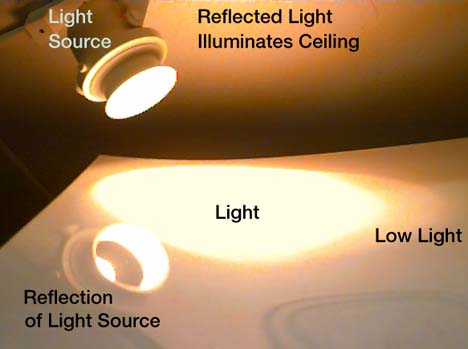Alzofon Art Institute Academy Lesson
<<<<Expanding Lesson>>>>
How Do You Do Shading?
Please come back again for new additions
Definitions
To discuss shading, I am using a set of words with very particular
meanings, which are defined here. Other publications may not agree with
all my terminology...
...But I'm the one who's right.

Make sure your browser is stretched out far enough to the right to
include whole illustration.
Definition Menu
Light Source
The most luminous element affecting any given environment.
This might be, for example, the sun, or, if the sun is obscured by a cloudy
overcast, then the overcast becomes the light source. The nature of the
light source plays a critical role in form description.

Photograph of lamp mounted to ceiling, illuminating white plastic sheet.
Secondary Light Source
Less luminous (than light source) elements affecting any given environment.
On a sunny day, the sky is a secondary light source to the sun. Highly reflective
surfaces can act as secondary light sources. The influence of illumination
from secondary light sources is important, but can never exceed the
influence from the primary light source.

Photograph of lamp mounted to ceiling, illuminating white plastic sheet.
The plastic sheet is acting as a secondary light source, as it reflects
illumination back to the ceiling.
(Back to menu)
Light (zone)
The area on form which is receiving illumination from the light source.
You can cast a shadow over the lit side of form.
While secondary light sources can illuminate shade zones, the contrast of
intensely illuminated light zones precludes any part of the shade
zone from being as light as any part of the light zone.

(Back to menu)
Halftone
The area along the boundary between shade and light where there is a
visible mix between shade and light.
Halftone is found only where textured form turns from light, and is not
the edge of a cast shadow.
Because halftone contains light, you can cast a shadow over the halftone
area.
Many people have trouble conceptualizing the halftone area, so I have made
a page with much more detail about this
area.
(Back to menu)
Shade (zone)
Area where the light source cannot illuminate, due to form turning
away, or to light blockage by a shadow casting body.
You cannot cast a shadow over the shade zone.

(Back to menu)
Medium Light
Area on form receiving a greater level of illumination from light source.
For an explanation of the levels of illumination, click
here.
(Back to menu)
Highlight
A reflection, focused or diffuse, of the light source.
The reflection of the lamp is the highlight. Because the surface is very
glossy, we see a reflection of the light source. An eggshell finish on the
same surface would soften the focus to such an extent that you would not
be able to identify the lamp anymore; but this area would contain the highlight
just the same.

Photograph of lamp mounted to ceiling, illuminating white plastic sheet.
As the observer moves about, the highlight moves; while light from illumination
is fixed. This is due to a basic rule about reflection, to be discussed
later.
(Back to menu)
Low Light
Area on form receiving a lesser level of illumination from light source.
For an explanation of the levels of illumination, click
here.
(Back to menu)
Core of Shadow
This is a compound effect:
- Within shade, due to the relative position of observer to an object
in open space, some parts of form bounce less reflected light back into
our eyes, thus appearing darker. Typically, this area will be a plane turned
toward us.
- The second factor -- completing the definition -- is the presence
of a lit side of the form. The illuminated side turns from the light, into
the darkened plane facing you. All these factors work in concert to create
the core of the shadow.

(Back to menu)
Reflected Light (as a light source)
Reflected light acts as illumination from non-primary light sources.
Reflected light influences color or lightness level on all parts of the
form, but its influence is most evident in the shade zone. Reflective surfaces
illuminate nearby forms, even if weakly. As light sources, reflective surfaces
cannot illuminate as strongly as the primary light source. The sky can be
thought of as a reflective medium.

Photograph of lamp mounted to ceiling, illuminating white plastic sheet.
(Back to menu)
Cave
Extreme recessions where, due to a closed configuration, light is prevented
from reflecting back to your eye.

(Back to menu)
Cast Shadow
Light rays travel in a straight-line path out from the source.
Objects block light rays from continuing along this path.
Areas behind the light-blocking body will not be illuminated. These areas
are said to have a shadow cast over them.
The boundary of a cast shadow can be plotted by running a straight line
from the light source to the edge of the light blocking form, down to the
next surface.
At the boundary of the shade zones, cast shadows
have a different edge quality than halftones. Cast shadows have penumbras.
Soon I will develop a section describing the nature of penumbras.
(Back to menu)
Back to: Shade, Light & Form Modeling Entrance
What's New? | Shortcut
Entrances: | Studio
| Alzofon Art Institute | Guest
Wing, Link Room | Idea
Library | Academy |
Rebecca Alzofon
can be e-mailed at rebecca@art.net
This page created October 9, 1996





